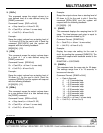
MULTITASKER™
400-0095-005
16
16
31. […F] – Feedback
After processing a command, an OK or ER will
be returned as feedback if "F" is included at the
end of the command string.
32. […P] – Path
This command sets the path for the output, but
is not active until the switch command, [SW], is
executed. Commands ending in "P" are not
executed immediately. The path for outputs on
one or more cards can be preloaded. See the
[SW] command for details.
33. [SW] – Switch
The switch command immediately connects
inputs and/or outputs, which were previously set
with the path command on this card and all
other cards in the system.
Example:
There is an MT109-100 in slot 2 and another
MT109-100 in slot 3. Switch C2 to Input 1 at the
same time a switching C3 to Input 4 by sending
the following commands:
[ON1C2P] [ON4C3P] [SW]
34. [TEST]
This command performs a series of tests on the
internal memory.
Upon completion, the system will display
"MEMORY IS GOOD" if all tests pass;
otherwise, failures will be indicated.
35. [FBD]
This command turns feedback delay on or off. It
is necessary when installing some newer cards
in older systems. If the system does not receive
all of the feedback from the card, the card may
be communicating too fast. This command will
slow down the card's communication rate.
Command Format: [FBDmCnUi]
m = Delay (0= no delay, 1= delay 100mS)
Cn = Card ID (n = # from 1 to max slots)
Ui = Unit ID (i = from 0 to 9)
Example:
The command [HELPC4] is sent to the card in
slot 4. Some of the data is displayed, but most
is missing. Send the [FBD1C4] to slow the rate
at which the card sends feedback to the system.
ID COMMANDS: RSI, SIDn, SIDnCi, SID+, RSN
The default Card ID is the card’s slot number.
The next several commands allow the ID to be
set to a value other than the slot number. Once
the ID is changed, moving the card to another
slot will not change the card ID. If a card in slot
4 is set to ID 1 then moved to slot 10, its ID will
remain 1.
Some cards require more than one slot in the
MultiTasker system. As an example, some
matrix switcher cards require 4 slots. If there are
5 of these cards installed, they would be
numbered C4, C8, C12, C16 and C20.
Changing the Card ID allows the user to define
the cards as C1, C2, C3, C4 and C5.
Another use for changing the Card ID is to be
able to use multiple systems without having to
set each unit to a different Unit ID. All systems
may be left as Unit ID 0 for ease of
programming. The cards in the first unit may be
numbered 1-10 and in the second unit 11-20.
The ID commands work with all MultiTasker
Front Panel systems. However, front panels that
have firmware releases prior to the following will
not be able to address Card IDs greater than
the number of slots in the system:
690-0122-019 = Version 019 or later.
690-0123-005 = Version 005 or later.
690-0124-019 = Version 019 or later.
Send the command [VER] and verify the
feedback includes the following:
690-0122-019 690-0123-005 690-0124-019
Check the last three digits against the numbers
above to determine if the Card ID commands
can address all 99 Card IDs.


















